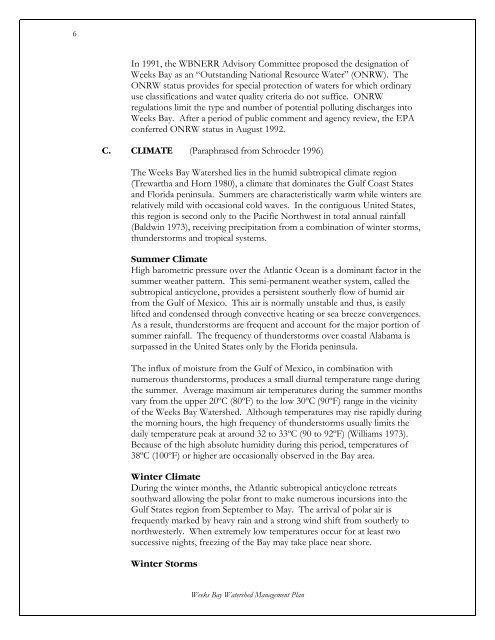Weeks Bay Watershed Project Management Plan - Mobile Bay ...
Weeks Bay Watershed Project Management Plan - Mobile Bay ...
Weeks Bay Watershed Project Management Plan - Mobile Bay ...
You also want an ePaper? Increase the reach of your titles
YUMPU automatically turns print PDFs into web optimized ePapers that Google loves.
6<br />
In 1991, the WBNERR Advisory Committee proposed the designation of<br />
<strong>Weeks</strong> <strong>Bay</strong> as an “Outstanding National Resource Water” (ONRW). The<br />
ONRW status provides for special protection of waters for which ordinary<br />
use classifications and water quality criteria do not suffice. ONRW<br />
regulations limit the type and number of potential polluting discharges into<br />
<strong>Weeks</strong> <strong>Bay</strong>. After a period of public comment and agency review, the EPA<br />
conferred ONRW status in August 1992.<br />
C. CLIMATE (Paraphrased from Schroeder 1996)<br />
The <strong>Weeks</strong> <strong>Bay</strong> <strong>Watershed</strong> lies in the humid subtropical climate region<br />
(Trewartha and Horn 1980), a climate that dominates the Gulf Coast States<br />
and Florida peninsula. Summers are characteristically warm while winters are<br />
relatively mild with occasional cold waves. In the contiguous United States,<br />
this region is second only to the Pacific Northwest in total annual rainfall<br />
(Baldwin 1973), receiving precipitation from a combination of winter storms,<br />
thunderstorms and tropical systems.<br />
Summer Climate<br />
High barometric pressure over the Atlantic Ocean is a dominant factor in the<br />
summer weather pattern. This semi-permanent weather system, called the<br />
subtropical anticyclone, provides a persistent southerly flow of humid air<br />
from the Gulf of Mexico. This air is normally unstable and thus, is easily<br />
lifted and condensed through convective heating or sea breeze convergences.<br />
As a result, thunderstorms are frequent and account for the major portion of<br />
summer rainfall. The frequency of thunderstorms over coastal Alabama is<br />
surpassed in the United States only by the Florida peninsula.<br />
The influx of moisture from the Gulf of Mexico, in combination with<br />
numerous thunderstorms, produces a small diurnal temperature range during<br />
the summer. Average maximum air temperatures during the summer months<br />
vary from the upper 20ºC (80ºF) to the low 30ºC (90ºF) range in the vicinity<br />
of the <strong>Weeks</strong> <strong>Bay</strong> <strong>Watershed</strong>. Although temperatures may rise rapidly during<br />
the morning hours, the high frequency of thunderstorms usually limits the<br />
daily temperature peak at around 32 to 33ºC (90 to 92ºF) (Williams 1973).<br />
Because of the high absolute humidity during this period, temperatures of<br />
38ºC (100ºF) or higher are occasionally observed in the <strong>Bay</strong> area.<br />
Winter Climate<br />
During the winter months, the Atlantic subtropical anticyclone retreats<br />
southward allowing the polar front to make numerous incursions into the<br />
Gulf States region from September to May. The arrival of polar air is<br />
frequently marked by heavy rain and a strong wind shift from southerly to<br />
northwesterly. When extremely low temperatures occur for at least two<br />
successive nights, freezing of the <strong>Bay</strong> may take place near shore.<br />
Winter Storms<br />
<strong>Weeks</strong> <strong>Bay</strong> <strong>Watershed</strong> <strong>Management</strong> <strong>Plan</strong>
















